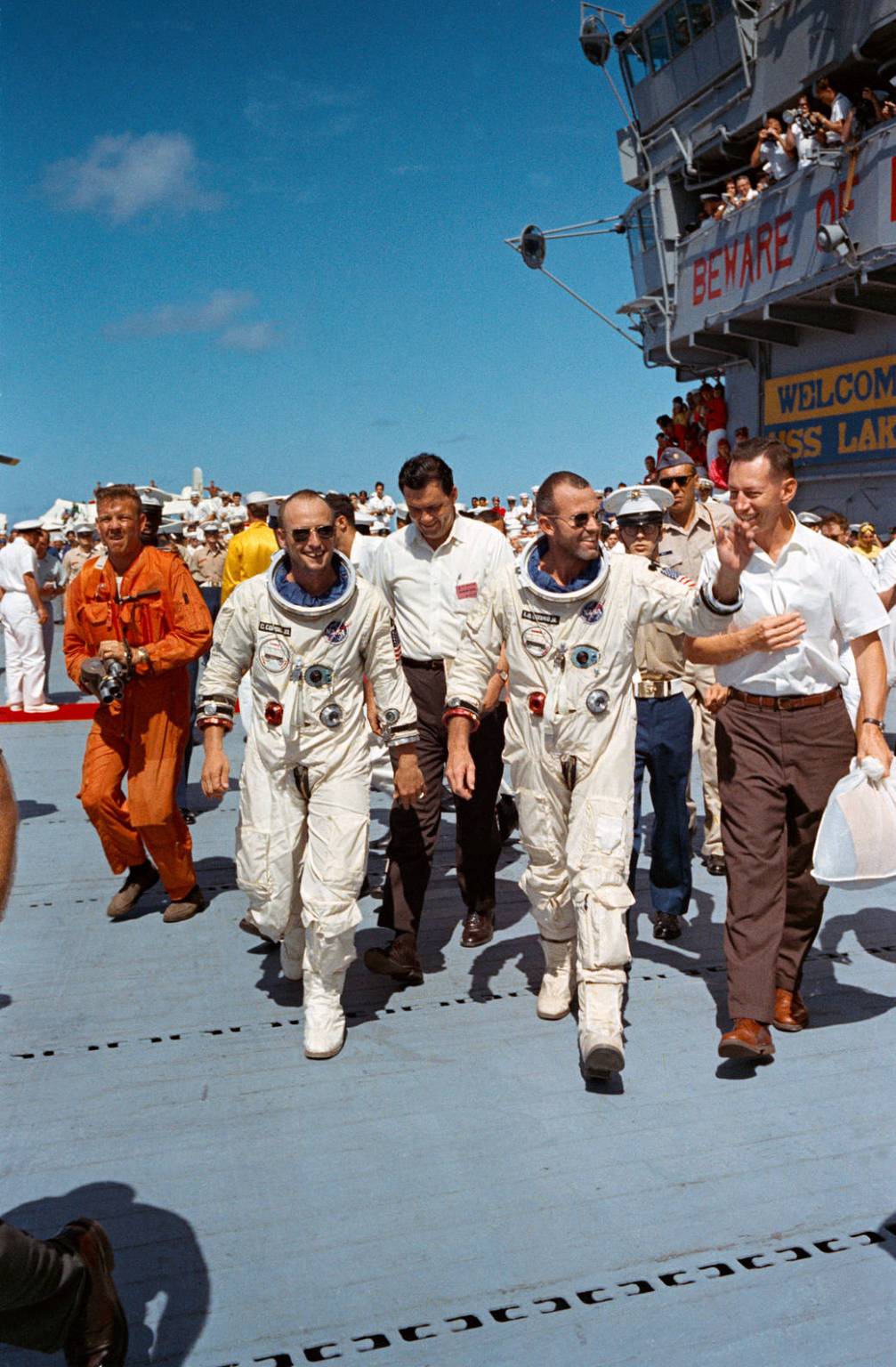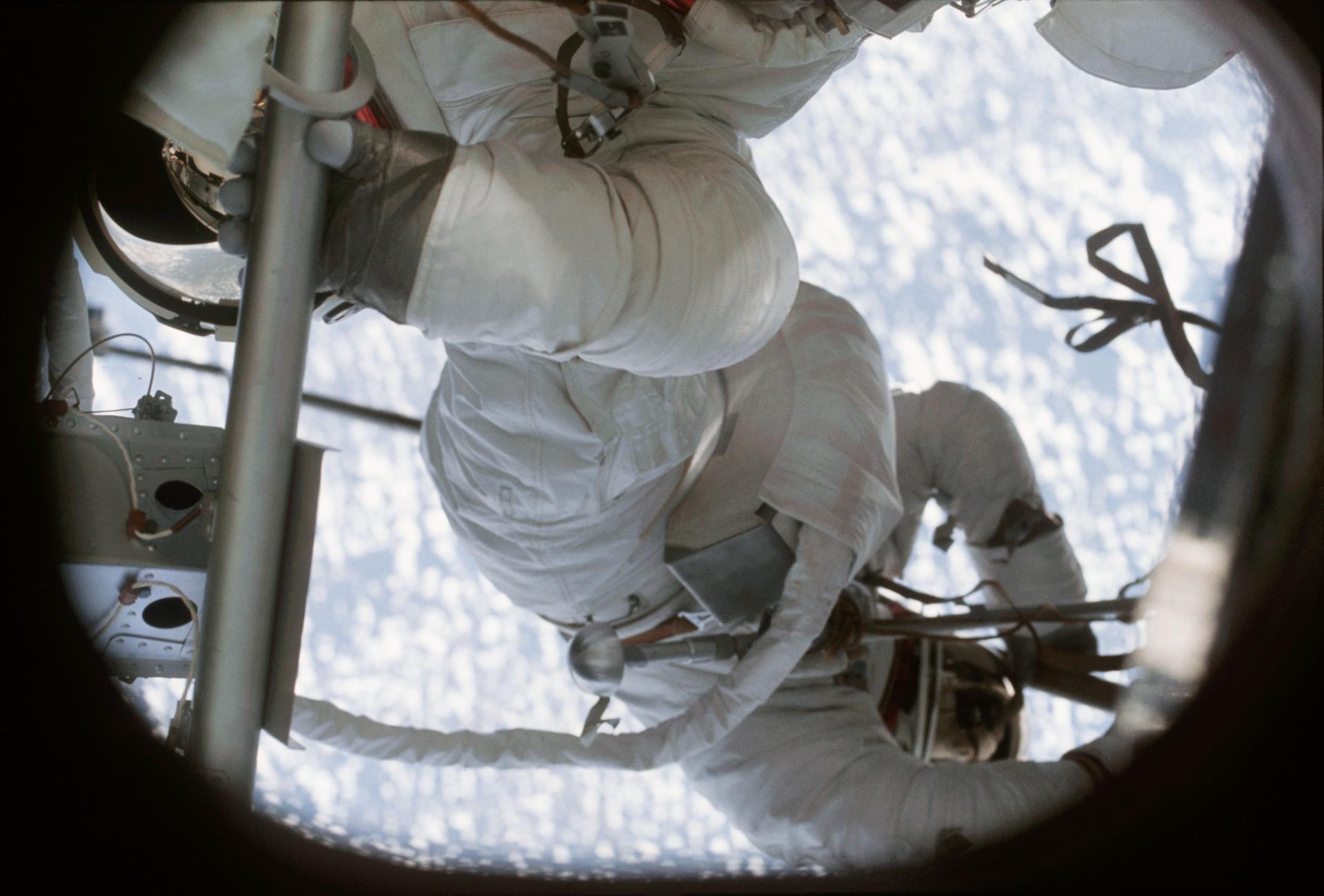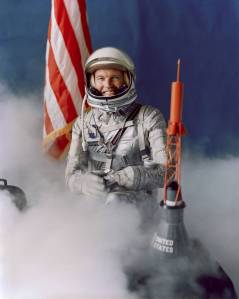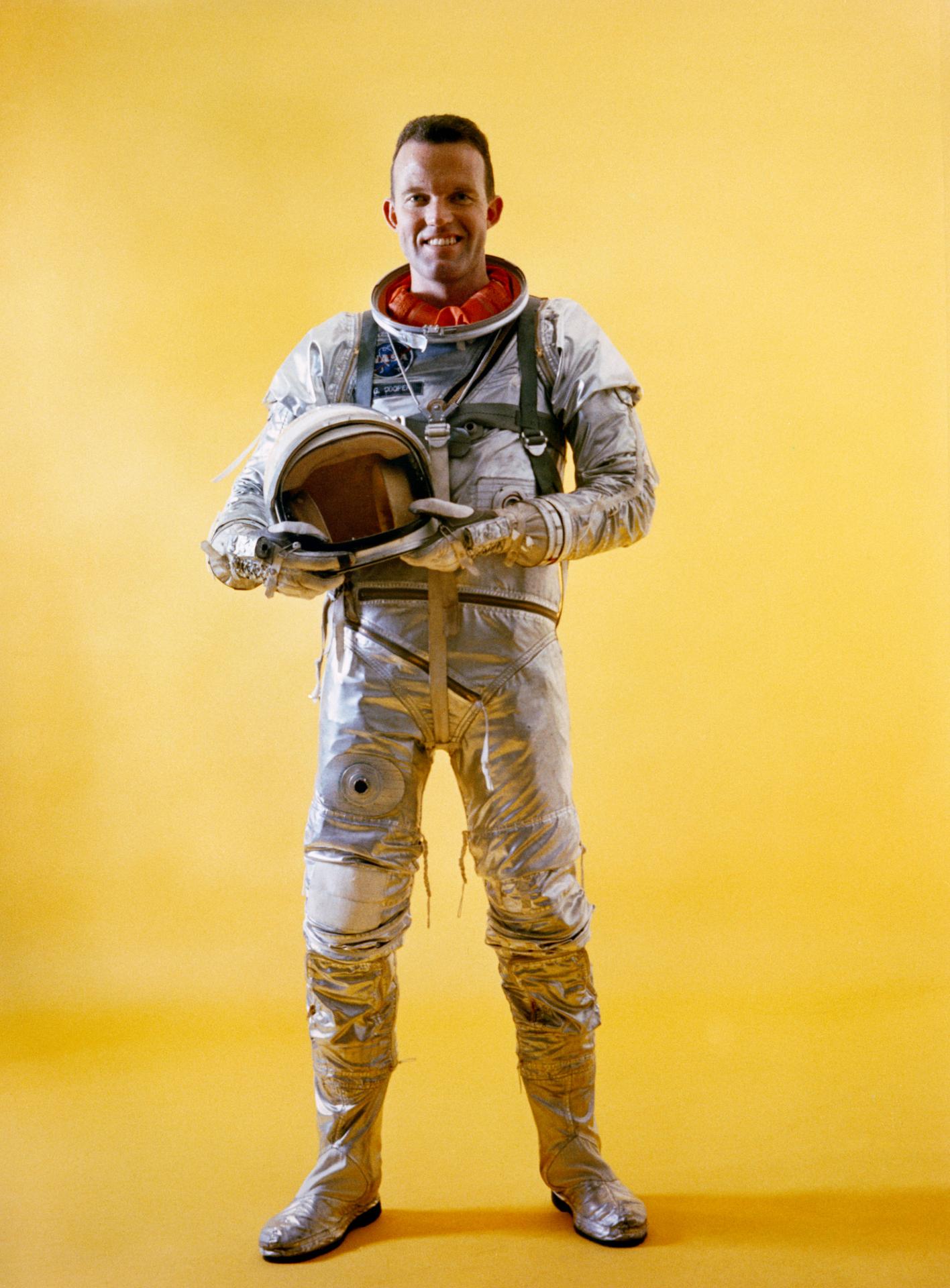During the summer of 1965, the United States began to pull even in the space race with the Soviet Union. The eight-day Gemini V endurance mission doubled America’s spaceflight record set two months earlier. It also tested technology that would help make longer missions possible in the future.
One of the lasting benefits of NASA’s Gemini Program was its sustained technological investments accumulated over a two-year period. These new capabilities allowed astronauts not only to meet the challenges for landing on the moon, but laid the groundwork for long-duration missions aboard the International Space Station and future flights to destinations that still await, such as a near-Earth asteroid and Mars.
Now, 50 years after Gemini V, NASA astronaut Scott Kelly and Russian cosmonaut Mikhail Kornienko are in the midst of a one-year stay in orbit aboard the space station. With the doubling of the length of the usual ISS stay, researchers hope to better understand how the human body reacts and adapts to longer-duration spaceflight. This knowledge is crucial as NASA looks toward human journeys to and from Mars, which could last 500 days or longer.
In addition to efforts to determine microgravity’s effects after more than a week in orbit, the crew of Gordon Cooper and first-time astronaut Charles “Pete” Conrad planned to attempt to catch up with an instrument package called the rendezvous evaluation pod (REP).
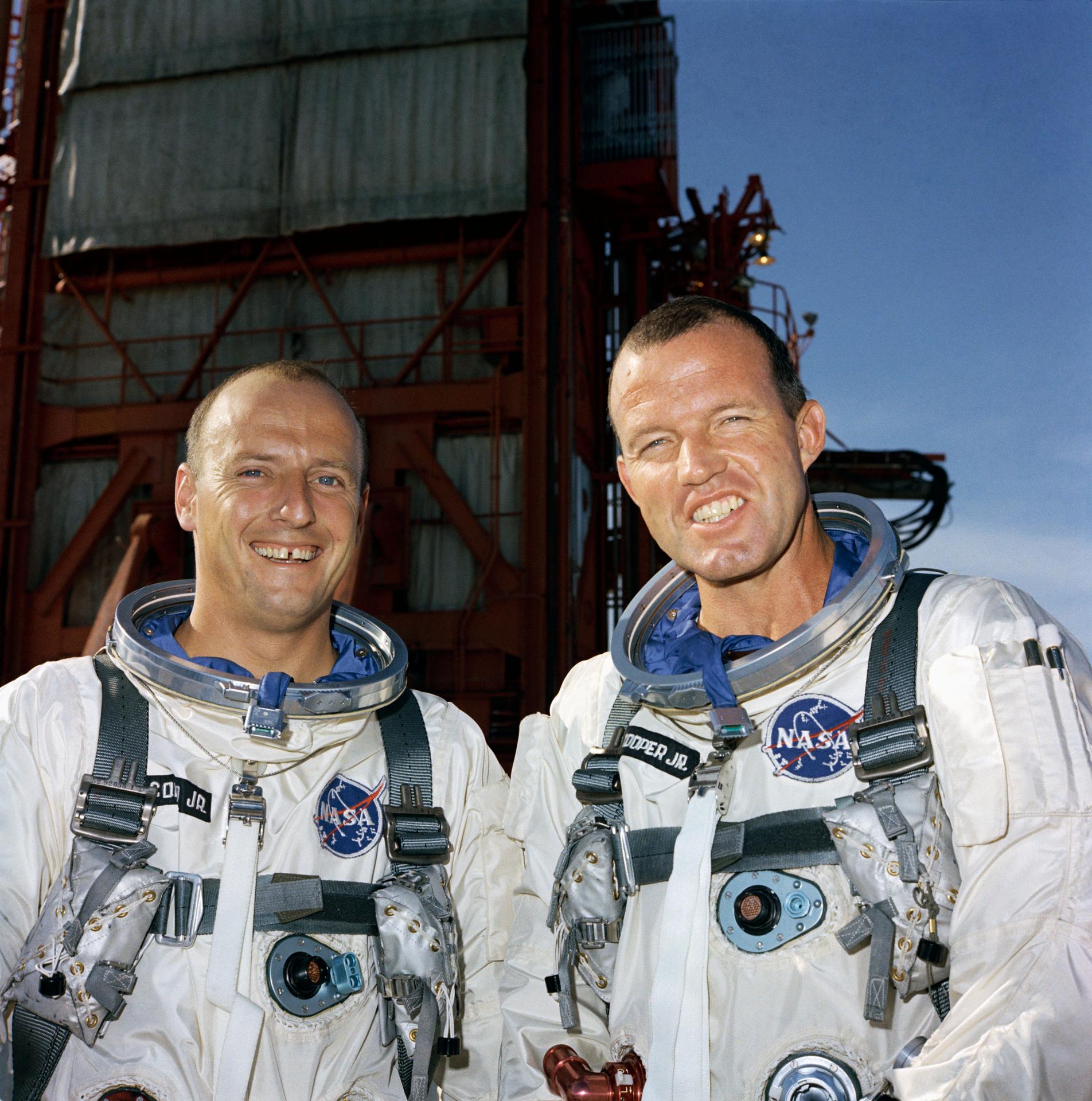
A member of the original seven Mercury astronauts, Cooper flew more than 34 hours and orbited the Earth 22 times on Mercury 9 during May 1963. Conrad was a member of the agency’s second group of astronauts. He would go on to command Gemini 11 in 1966, walk on the moon during Apollo 12 in 1969 and lead the first Skylab crew in May and June 1973.
As flights became longer and more complex, the NASA team at the Kennedy Space Center and Cape Kennedy (now Cape Canaveral) Air Force Station intensified its efforts to ensure mission success. The Florida spaceport’s NASA test conductor for Gemini V was Chuck Gay. He and a team of specialists conducted nine weeks of capsule factory tests and inspections at the McDonnell Aircraft Corp. in St. Louis where the spacecraft was built. The capsule then was flown to Kennedy for another eight weeks of prelaunch checkouts.
“A great deal of knowledge was gained during the four previous Gemini missions, particularly the two manned flights,” Gay said in a 1965 interview. “Extremely rigid specifications were tightened even further for Gemini 5, and inspection procedures were more stringent than those previously used.”
He noted that the scrutiny was due to the new, untested procedures planned for the upcoming flight.
“Gemini V will demonstrate an eight-day long-duration capability for both the spacecraft and crew,” he said. “In addition, this will be the first use of fuel cells for supplying spacecraft power during a manned flight.”
A fuel cell converts energy from a fuel, such as liquid hydrogen, into electricity through a chemical reaction with liquid oxygen or another oxidizing agent. By comparison, a battery stores the chemical reactants. Once used up, a battery must be recharged or discarded. A fuel cell will continue to produce electricity as long as it has a fuel supply, a crucial technology for long-duration spaceflights.
Gemini V astronauts Cooper and Conrad also were the first to design an insignia patch for their flight. The original version featured a Conestoga covered wagon, noting the pioneering effort of Gemini. On the side was the slogan “8 Days or Bust.”
After the design was submitted for review to NASA Administrator James Webb, he wrote Director of Flight Crew Operations Deke Slayton, approving the concept but expressing reservations about the slogan.
“I have a very strong concern about the ‘8 days or bust’ motto,” he said in the Aug. 14, 1965, memo. “I wish it could be omitted. If the flight does not go eight days, there are many who are going to say it was ‘busted.’”
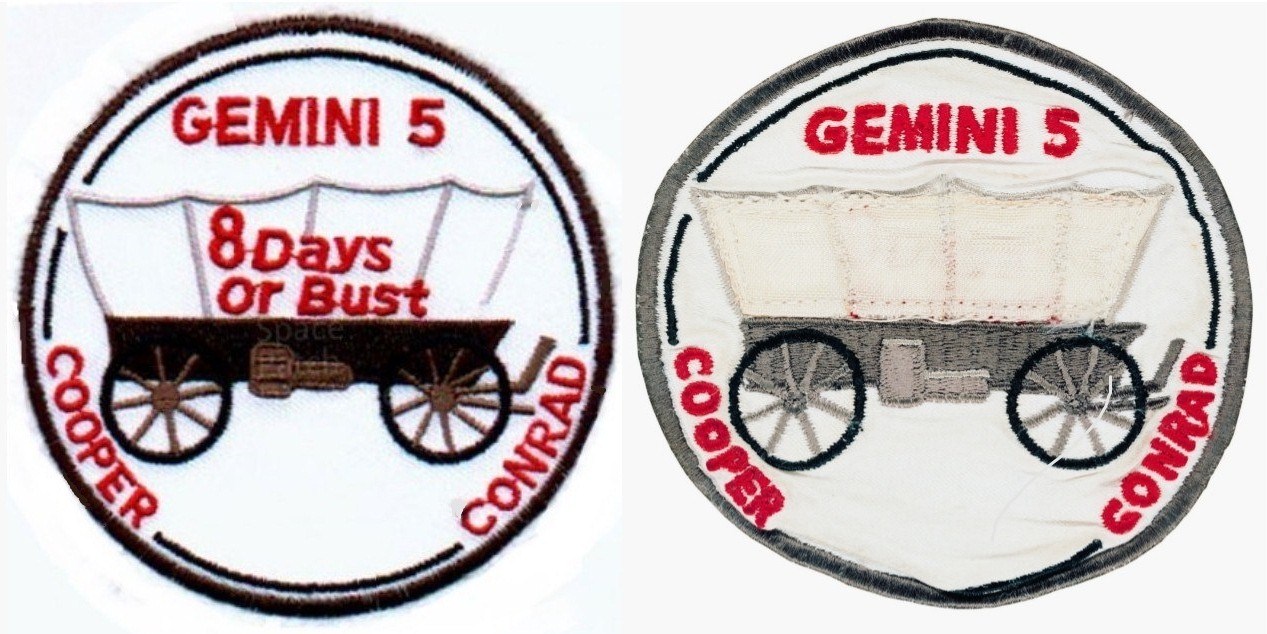
Since the patches were already produced with the slogan, fabric was sewn over the motto on the patches worn by Cooper and Conrad during the flight.
“We’re on our way,” said Cooper as Gemini V lifted off from Cape Kennedy’s Launch Pad 19 on Aug. 21, 1965.
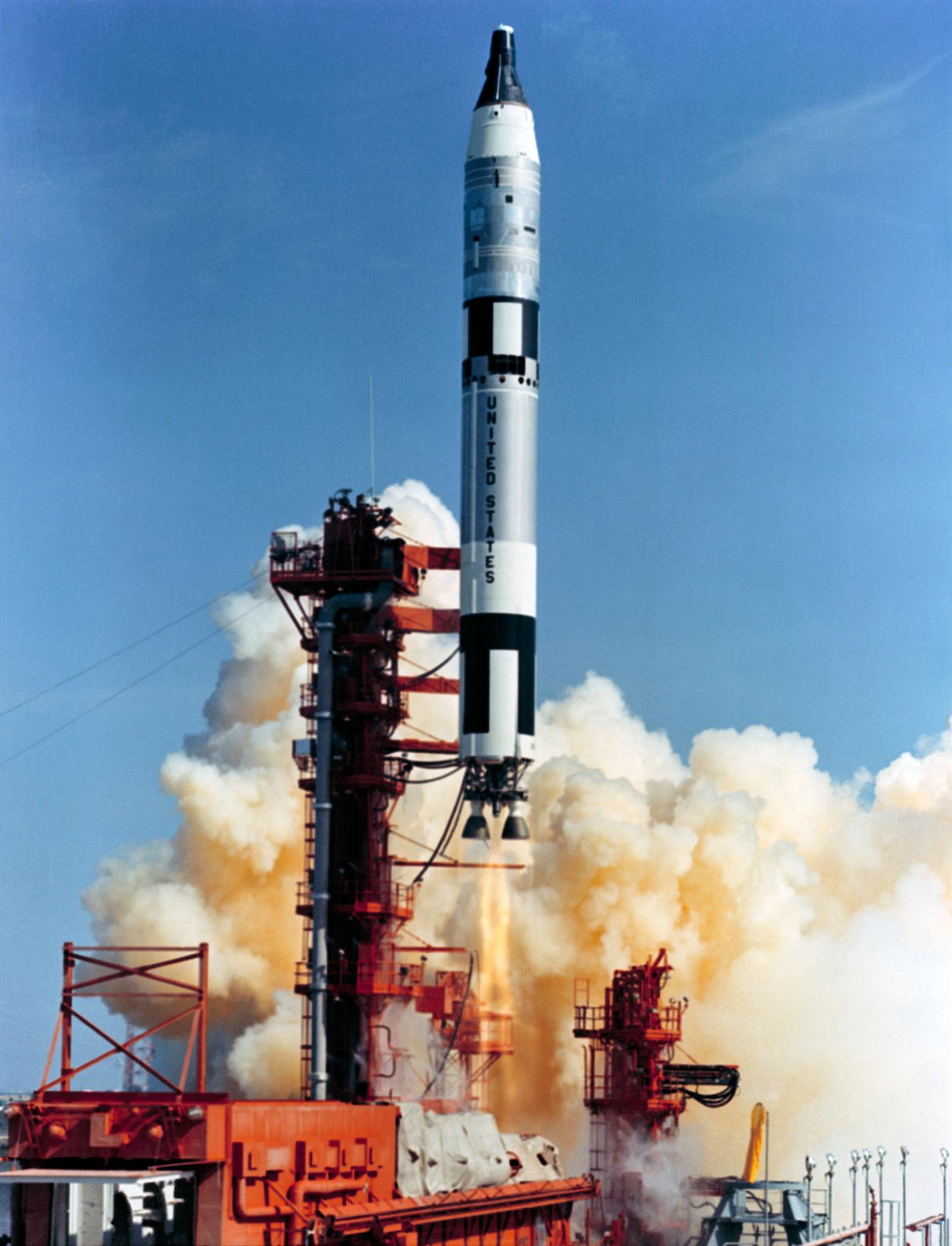
The first major test was to practice tracking and catching up with the rendezvous pod. The 74-pound package was ejected from the adapter at the back of the spacecraft during the second orbit.
“We got the REP out,” said Conrad. “It’s moving away at four feet a second on our radar.”
The pod contained a radar transponder, flashing beacons, batteries and an antenna. The plan called for Gemini V to maneuver away from the instrument package, six miles below and 14 miles behind, and then rendezvous with the pod.
About half an hour after deploying the REP, fellow astronaut Jim McDivitt, serving as capsule communicator in mission control, asked the crew to check the fuel cell heaters to maintain proper pressure in the reactant tanks. The new electricity generators were not performing as expected.
“We have checked that,” Cooper said. “I can’t get an increase in amperage when I go to manual O2 (oxygen) fuel cell heater, nor do I get any reading in amperage when I go to auto. The H2 (hydrogen) heater works perfectly.”
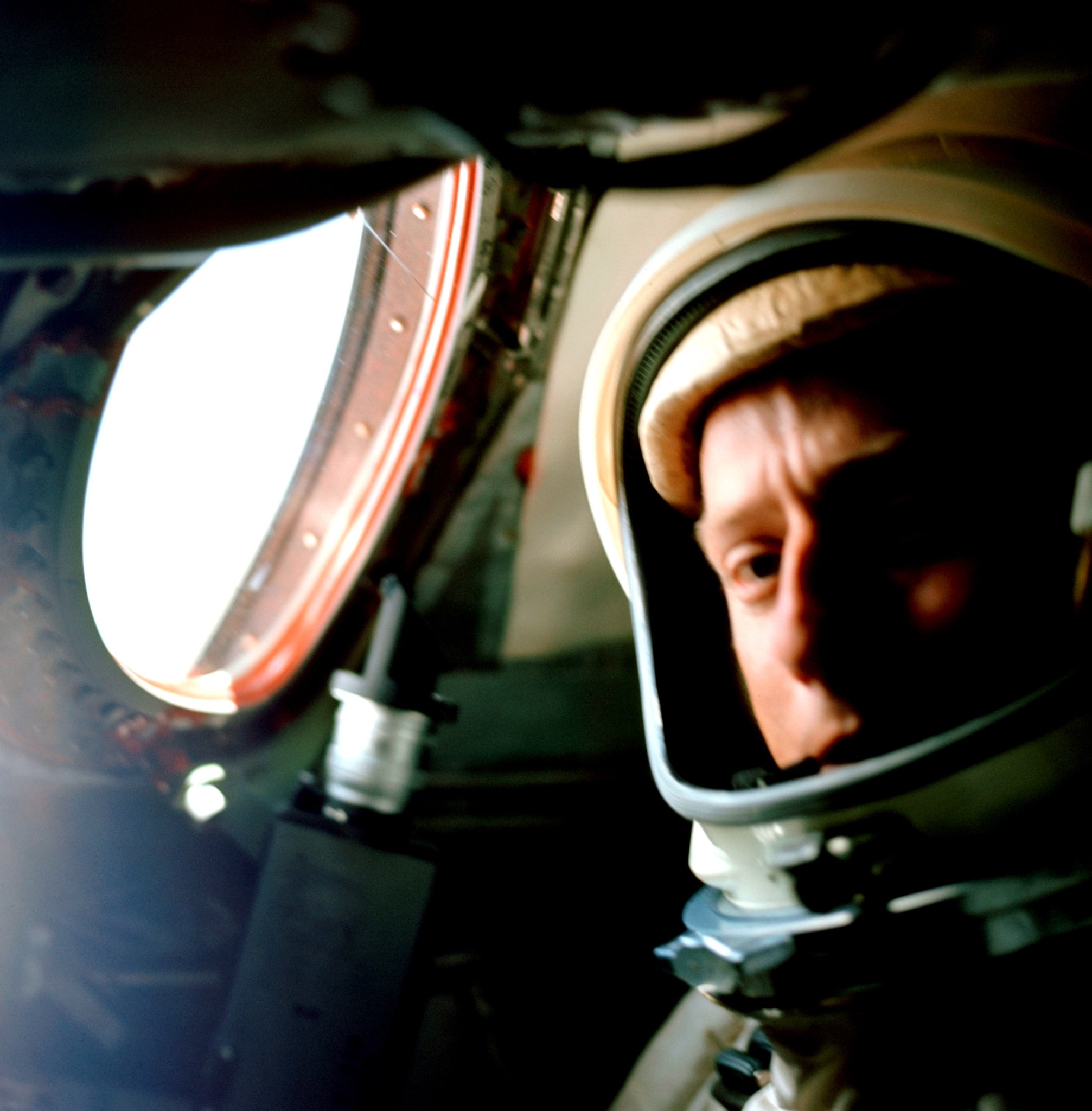
While out of radio contact with the ground, the crew found that the pressure in the fuel cells continued to drop.
“We have decided to power down the radar and we’re in the process of powering down the spacecraft,” said Cooper when Gemini V passed over the next tracking station. “Our fuel cell oxygen pickup is still falling.”
Tracking the REP was cancelled and consideration was given to bringing the crew back early. However, engineers at the McDonnell Aircraft facility in St. Louis conducted quickly arranged tests showing that it was possible for the fuel cells to work, even with low oxygen pressure.
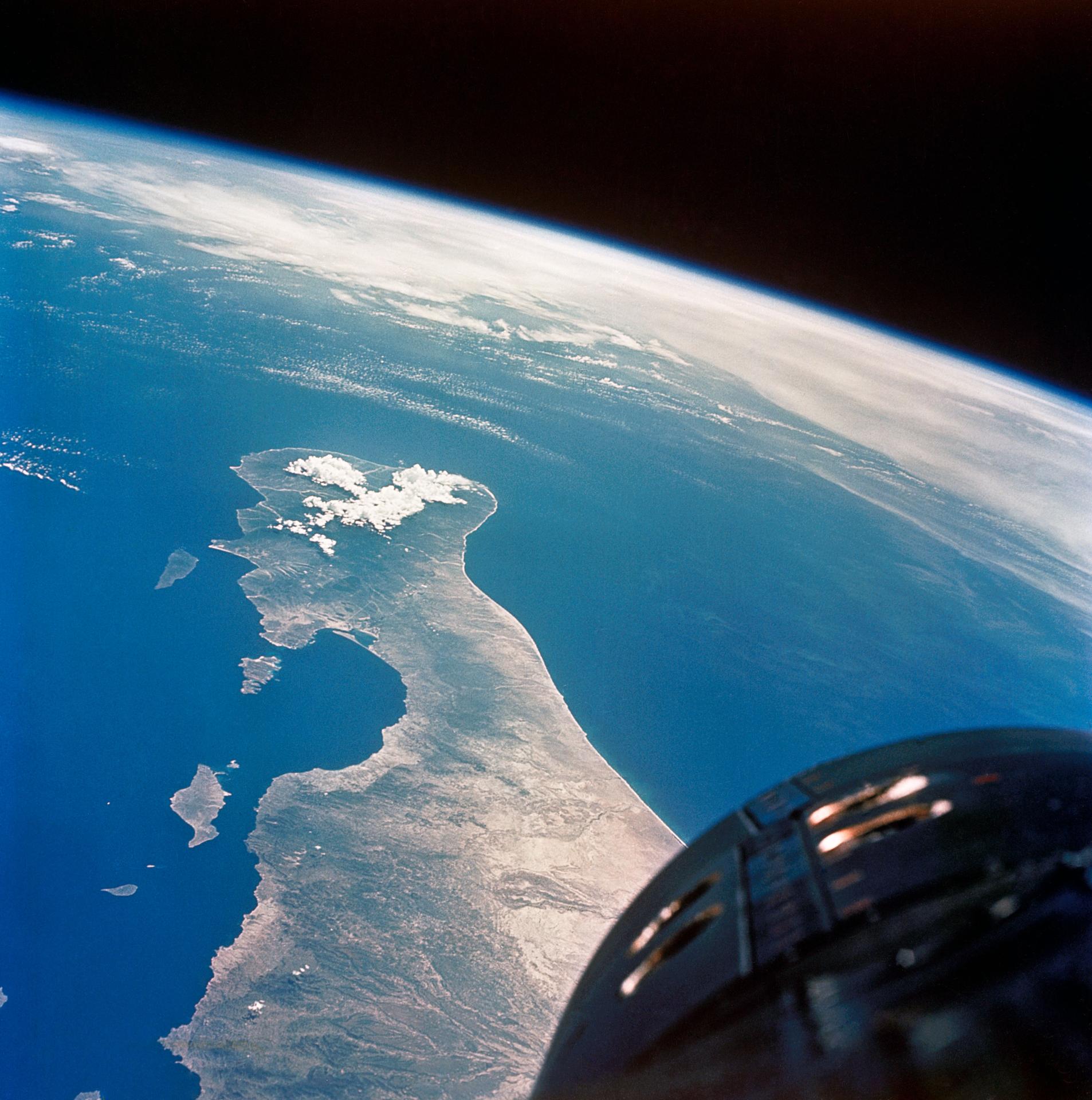
With this reassurance, flight director Gene Kranz and his mission control team decided to tell Cooper and Conrad to turn the electricity back on. They were relieved when the fuel cells were restarted and tested by using equipment that required more and more power. This showed that the fuel cell pressure remained stable and the crew could continue its mission.
In the meantime, fellow astronaut Buzz Aldrin developed an alternative rendezvous test since the REP was no longer available. His astronautics doctoral thesis from the Massachusetts Institute of Technology was “Guidance for Manned Orbital Rendezvous.” Aldrin worked out a plan in which the crew could rendezvous with a “point in space.” It went perfectly, and marked the first-ever precision maneuvers on a spaceflight.
The Gemini V crew went to work on other experiments planned for the mission, including high-resolution photography, medical experiments similar to those performed on Gemini IV, as well as an experiment into the performance of the human heart in microgravity.
Cooper and Conrad returned to Earth on Aug. 29, 1965. They controlled their re-entry, creating drag and lift by rotating the capsule. Even so, the crew splashed down in the Atlantic Ocean about 80 miles short of the planned landing point due to a computing error. A helicopter from the recovery ship, USS Lake Champlain, soon picked up the Gemini V crew and took them to the aircraft carrier.
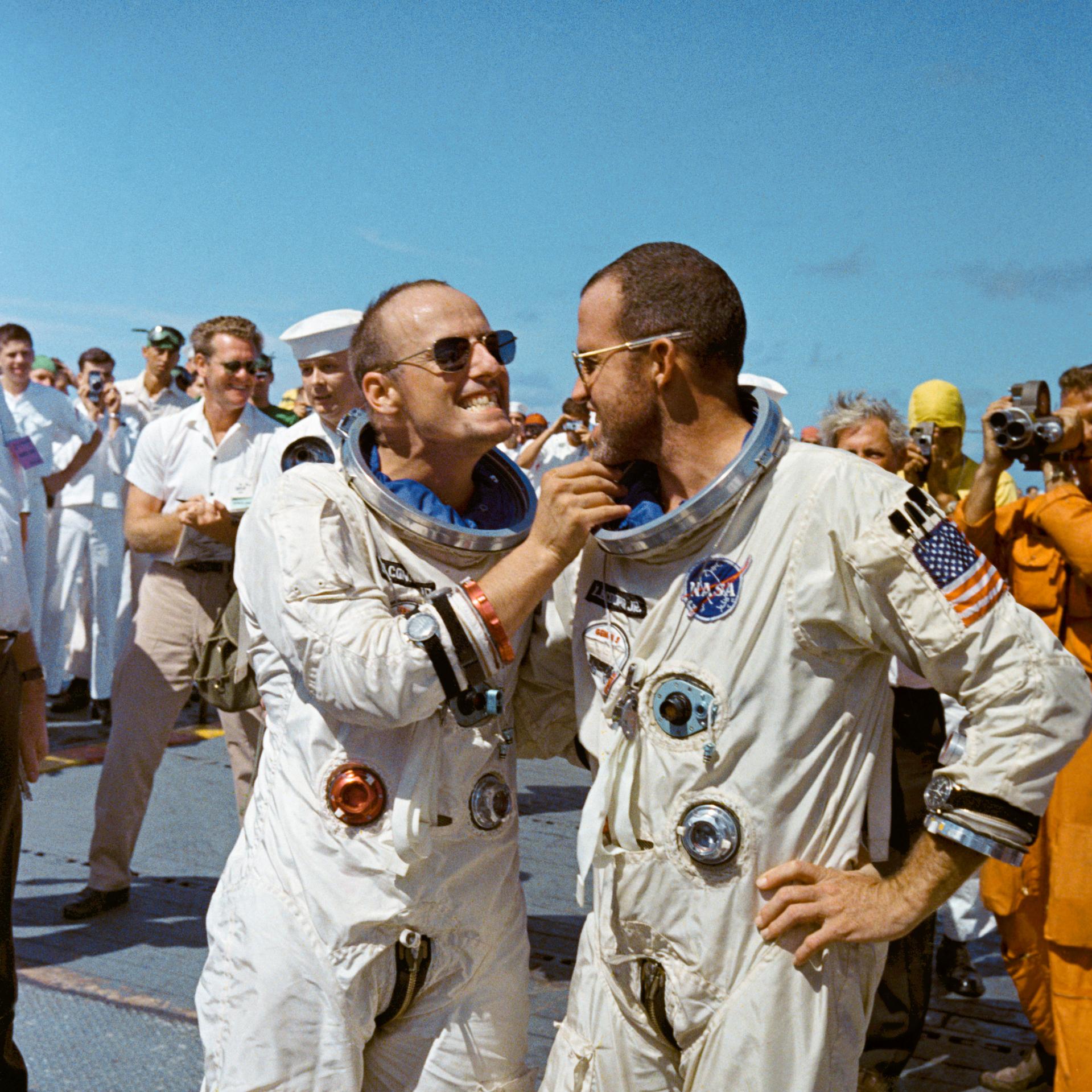
The day after the splashdown, Cooper and Conrad returned to Kennedy for three days of medical checkups.
“It’s good to be back here at the place where we spent our last weeks in training,” said Cooper upon arrival.
NASA Deputy Administrator Hugh Dryden summed up the success of Gemini V in a Sept. 11, 1965 report to President Lyndon Johnson.
“The primary objective of the Gemini V mission was to demonstrate man’s ability to function in the space environment for eight days and to qualify the spacecraft systems under these conditions,” he said. “The adaptability of the human body was indicated by the performance of the astronauts. This has assured us of man’s capability to travel to the moon and return.”

By Bob Granath
NASA’s Kennedy Space Center, Florida
EDITOR’S NOTE: This is the third in a series of feature articles marking the 50th anniversary of Project Gemini. The program was designed as a steppingstone toward landing on the moon. The investment also provided technology now used in NASA’s work aboard the International Space Station and planning for the Journey to Mars. In December, read about two Gemini crews meeting in orbit.


























